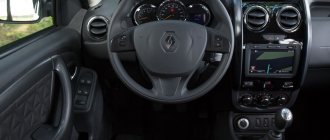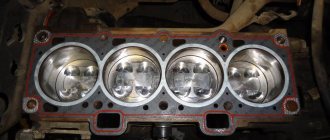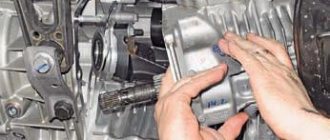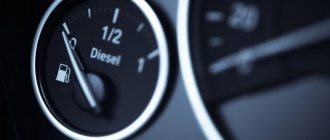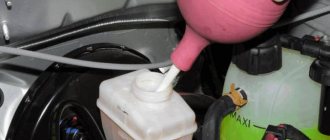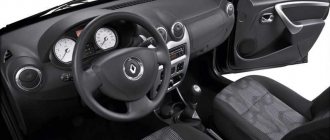Renault Duster quickly became popular thanks to its elegant design, ease of repair and virtually indestructible suspension - those sitting in the cabin feel comfortable on any road. That's what the advertisement says. The reviews from drivers are the most contradictory; they mainly concern used models. Indeed, the engines before restyling were inferior to those that came out after 2015. But their price is more expensive. Experts still advise refraining from cheaper, older modifications - you will have to pay for the low price in the transaction with expensive repairs and it may well turn out that the old car will require much more investment than the new one. Particular attention should be paid to gaps, behavior during operation, and movements. The quality of movement depends on which engine is installed in the Renault Duster. It is important to pay attention to the choice of this mechanism.
What engines are installed on this car: in Russian showrooms there are mainly modifications in which the fuel is gasoline (AI 92, 95.98), less often - diesel, all of them are installed on Renault Duster. The latest generation modifications from 2015 are good friends with Russian roads, do not have a big appetite for oil and gasoline, and are quite powerful engines. However, there are other features that, if ignored, can spoil the entire purchase experience, but which engine is better can only be found out by comparing them. Renault Duster has an engine: gasoline and diesel - when choosing, you need to think about what is profitable for you to refuel. Of course, Diesel 1.5 is economical and despite its small volume, it is powerful.
Types of engines that were installed on the car - technical characteristics, price and features
Let's look at all the strengths and weaknesses of Renault Duster. Or more precisely, how good is its engine: the characteristics of the engines are below in the table. It is clear that there are no problem-free options. Both 1, 6 and 2 liter engines of 135 hp, 143 hp, and 114 hp each have their drawbacks, including fuel consumption.
| Company | Volume, l | Power, hp | Torque H*m at rpm | Trans- ia | Drive unit | Peculiarities | Consumption per 100 km, l |
| 16v K4M, petrol | 1,6 | 102 | 145 at 3750 | Fur. | 4-wd | Drives quickly and smoothly when accelerating to 4000 rpm and higher. Count- is perhaps the most balanced for this model. This is what they sell the cheapest spare parts for. Current the moment is not released, including due to non-compliance with the European safety standard Euro5. | 7,5–10, 5 |
| 16v H4M, petrol (aka Nissan HR16DE) | 1,6 | 114 | 156 at 4400 | Fur. | 4-wd | The aluminum block, which sounds like a death sentence, cannot be repaired. There are no hydraulic compensators. Washer valve clearance adjusters. Resource - 350 thousand km. | 7,5–9, 5 |
| 16v F4R, petrol | 2,0 | 135/143 | 195 at 3750 | Fur. | 4-wd | Simple and durable. Almost indestructible thanks to the cast iron block. There are hydraulic compensators. Weak points are the phase generator, ignition coils, crankshaft position sensor. Bad throttle valve. | 8–10,5 |
| 8v K9K, diesel | 1,5 | 149 | 250 at 1750-2950 | Fur. | 4-wd | Aluminum “head” without hydraulic compensators, cast iron block. A motor in this category has the most restrained “appetite” for fuel. | 4,4–5,8 |
And yet, some of the difficulties remained unresolved. The main one is clutch. It is characterized by weak leaf and damper springs. Therefore, experts do not advise delaying replacing the clutch for too long, but choosing a stronger one instead of the original one.
The connection between the working cylinder and the release bearing was also an error. It is impossible to predict how long it will last - maybe 50 thousand kilometers, or maybe five times more. Plastic pipes near the hydraulic main often break.
The range of volumes available on Dusters
Currently there are Duster configurations with the following engine types:
| Type | Tank volume, cubic cm | Power, hp | Type of fuel | Brand |
| 1.5 l., manual transmission, all-wheel drive (4WD) | 1461 | 109 | Diesel | K9K |
| 1.6 l., manual transmission, front-wheel drive | 1598 | 114 | Petrol | H4M |
| 1.6 l, manual transmission, all-wheel drive (4WD) | 1598 | 114 | Petrol | H4M |
| 2.0 l, manual transmission, all-wheel drive (4WD) | 1998 | 143 | Petrol | F4R |
| 2.0 l, automatic, all-wheel drive (4WD) | 1998 | 143 | Petrol | F4R |
The main advantages of gasoline engines
Each of the presented Renault Duster engines is actually good in its own way. All of them are economical, meet Euro-5 standards, and have also proven themselves to be the best among Renault car enthusiasts. As for specific fuel consumption figures, the 1.6-liter modification consumes on average 9 liters per 100 km in the urban cycle. On the highway, the average consumption is 6.5 liters. The two-liter version surprisingly turned out to be not much more voracious - the difference is only 1 liter.
It is for this reason that the two-liter version has recently begun to gain popularity. But it is still not possible to surpass its “younger brother” in terms of sales volume. The Renault Duster 1.6 K4M engine, despite the fact that it has less power, is most often chosen. The main reason is the price. Renault Duster with this type of engine is one of the best cars today in the budget car segment. In addition to comfort, efficiency and reliability, the owner of the car will also be able to be content with acceptable fuel consumption and a fairly long service life - 300 thousand km.
Duster engines: which one is better
As for the type of engine - here the opinions are unanimous - modifications to the K4M and the pre-styling F4R should be avoided. That's why:
It was no coincidence that the K4M was discontinued from production, despite its high maintainability and low price of spare parts. But it is often found on the secondary market. This power unit is very low-power and does not comply with Euro5 class. F4R in cars before 2015 is generally not bad, but it really doesn’t like sub-zero temperatures. It may refuse to start at all. His timing belt and phase generator often break. Restyling solved these problems; cars with it are reliable and will not require repairs for a long time. If efficiency is a priority, it is better to purchase the K9K 1.5 DCI modification. This motor has the lowest “appetite”. True, it is not very powerful and is very demanding on fuel quality. It is best to purchase a gasoline all-wheel drive Renault Duster and have an engine power of at least 143 horsepower. Not less. The 2-liter engine capacity is more popular than 1.6 and 1.5, but it has one big drawback - phase generators that break down quickly. Ignorance of this is often exploited by dishonest used car sellers. Therefore, when inspecting a gasoline Renault Duster, you should listen to how the engine sounds. A smooth hum should be heard from a working gasoline unit; if there is even a slight diesel crackle, you should refuse to purchase.
It is better if the car has a manual transmission (F4R or HR16dE H4M 114 hp). Important: if possible, it is better to opt for a “chain” one, since the timing belt on Renault Duster requires replacement every 60,000 km, and the chain lasts for 200 and 300 thousand.
Engine reliability and their weaknesses
The weak point of the K9K diesel engine is its injectors. They are sensitive to fuel quality. The injectors become coked, causing the spray pattern to change. As a result, the power unit loses traction and fuel consumption increases.
Injectors
Another weak point of the diesel power unit is its liners. They often turn out, leading to the need for major repairs. Therefore, many car owners change liners every 60 thousand km. To extend their service life, it is recommended to change the oil in a timely manner and monitor its quality.
Worn liners
All Renault Duster engines are characterized by the problem of soot formation and coking of the piston rings. A drop in compression is accompanied by a deterioration in dynamic performance. Not only does fuel consumption increase, but also progressive oil loss appears. The problem can usually be fixed only by overhauling the engine.
Coking of piston rings
With significant mileage, sometimes exceeding 500 thousand km, excessive wear of the CPG appears. Initially, the exhaustion is manifested by the knocking of the engine when cold. Subsequently, the power unit noticeably loses power, and the oil burner begins to manifest itself by losing liters of oil. Solving the problem usually requires a major overhaul of the motor.
Wear of the cylinder mirror
The weak point of the K4M and F4R engines is the timing belt. It does not always withstand the allotted service life. A broken belt significantly disrupts the operation of the internal combustion engine, causing the pistons to hit the valves. Timely inspection and replacement helps prevent belt rupture and chipping of its teeth.
K4M Engine Timing Belt
Gasoline consumption on engines
In terms of gasoline consumption, it all depends on where the owner is used to driving and on what roads.
On average, this is approximately 6.5 liters per 100 km, provided that the person behind the wheel does not drive recklessly and drives mainly on the highway.
Traffic jams significantly spoil these indicators. Without them, consumption is in the range of 10.4–11.5 liters, at average speed:
- 33-35 km/h - about 10.5 liters per 100 km;
- 18-20 km/h - less than 12 liters for the same distance.
The data is valid for summer tires and alloy wheels.
There are a variety of engines for Renault Duster. What drivers don’t want their car to last a long time; besides, it is a reliable, strong crossover, although it is inferior in quality to the same Volkswagen. So, if you are choosing Duster engines, which one is better and more practical? If possible, it is better to buy new cars with a diesel engine. Although such a model will cost more. If your budget does not allow you to purchase a new one, you need to be extremely careful when inspecting and checking the engine. A low mileage is far from the worst thing that such a purchase can conceal; you should carefully study the weak points of the Renault Duster, look closely, and listen to the running engine. The machine may have a faulty chain or belt or other parts. Even if the car has a diesel engine. At the slightest suspicion of a crack, it is better to refuse the deal; this is a sure sign of an impending major overhaul. The price of which bites. In general, if possible, it is better to buy a model older than 2015 - it will last a long time and will not cause unpleasant surprises in the form of, for example, a broken turbopump or clogged filters.
Which engine is better to choose Renault Duster
Most car owners believe that the Renault Duster crossover drives best with a diesel engine. Therefore, it is recommended to give preference to the K9K motor. The power unit not only shows excellent dynamics, but is also economical. The wide popularity of the engine has led to the fact that almost all car repair shops undertake to repair it. At the same time, there are no difficulties with finding spare parts during repairs.
Engine K9K
In the pre-restyling version, the Renault Duster with the K4M engine deserves attention. The motor has a long service life, which often exceeds 500 thousand km. The engine is not sensitive to the quality of gasoline. There is no need to adjust the thermal clearance of the valves. The internal combustion engine has new and used spare parts available.
Engine K4M
It is recommended to choose a car with an F4R engine if you purchase a used Renault Duster. The engine has a good service life, which is ensured by a simple design. Thanks to the high popularity of the internal combustion engine, finding spare parts for the F4R is not difficult. During operation, the engine requires minimal attention, since the cylinder head contains hydraulic compensators.
F4R powertrain
When purchasing a restyled version of Renault Duster, it is recommended to pay attention to a car with H4M. The motor fits into modern environmental requirements. It doesn't have any major reliability issues. The internal combustion engine is characterized by low fuel consumption, as well as the availability of spare parts.
H4M powerplant
How much oil does the engine need?
As for oil “appetites”, Duster is distinguished by moderation. But in this regard, it is better to choose models younger than 2013; older ones, especially those with a DP0 automatic transmission, will have to take into account the fact that they do not like driving without pre-warming. If you drive without warming up, the power unit will not last long. The oil consumption of the DP0 series according to the service book and in real life is different. Experts advise updating the oil every 8,000–10,000 km. Then the car will last longer.
It is also better to take modifications for Renault Duster with a manual transmission only new ones, after 2013, and even better, 2015. In old ones, the engine literally “floats” in oil due to (not modified) defective oil seals, no matter what the volume: 1.5, 1.6 or 2 liters.
When replacing with a Renault Duster, the following volume of engine oil is needed: on a 2 liter 16V engine - 5.40l, 1.6 16V - 4.80l, 1.5 dCi - 4.5l.
Sixteen-valve two-liter engines for Renault Duster are available with 143 and 180 “horses” and will require 4.35 and 5.55 liters of oil, respectively. Almost the same as a 2 liter engine, 1.6 and 1.5.
Where is the Renault Duster engine number?
Difficulty also arises with checking the engine number and VIN. There are reasons for this. The engine number on a Renault Duster is usually located in a place where you won’t be able to see it the first time. And perhaps even from the second. So, for the 2.0 F4R engine with 135 horsepower, it is located above the oil filter on the right, on the front wall. If you know where to look for the numbers, you just need to put your hand with a smartphone with a flashlight on between the radiator and the engine, where the number is located, take a photo, then look. The number is also well hidden on the diesel version (one and a half K9K with 90 “horses”). You need to look for it on the front of the engine under the oil dipstick. Without a flashlight and mirrors, it is almost impossible to detect it. The easiest way to find the number is for the 1.6 HR16DE modification with 114 hp - the numbers on the engine are visible from the front, on the flange connecting to the gearbox. It will be a little easier to find the VIN. It can be seen on the right “cup” at the front. However, you need to remember: the markings quickly become unreadable due to corrosion and peeling paint. The situation is even worse with VIN stickers; they become unusable after the first couple of years of use. Therefore, if the car is used, you need to find it and check by checking the license plates whether the plates will be of such quality. After purchasing a car, it is better to protect the VIN with a protective layer, at least with simple grease. Unreadable numbers may not be missed by the inspector during reconciliation!
Engine characteristics
Technical characteristics of Renault, which has a 2.0 engine whose design has been improved, includes the following parameters:
Reviews from owners of this brand are very contradictory, but if we start comparing the engine with its predecessor, then progress is visible to everyone. The power has increased by 8 l/hp, the maximum speed of the car and its thrust have increased accordingly, and fuel consumption has remained almost unchanged, but the environmental standard has increased to EURO-5.
Duster engine life
For Renault Duster, the engine life is usually calculated at 250–400,000 km, depending on the modification and year of manufacture. Let us remind you that an oil service is needed every 8–10 thousand kilometers. Otherwise, the turbocharger on the Renault Duster will break down approximately twice as fast as planned, which is approximately 200,000 km. Or the connecting rods will break due to dirty lubrication; this can happen to a car with any engine size: 2 liters, 1.5 or 1.6.
And in general, the Duster pump is not very durable; it usually lasts 150,000 km, less often 200 thousand (only for restyled models). This is another plus in favor of the fact that when buying a used Duster, it is better not to mess with very old modifications, especially for diesel engines older than ten years. The point is not only that many of them have almost dead turbochargers and oil pumps. Most of them were produced with Common Rail Delphi equipment, which is not friendly to air, due to the risk of airing. These power units are also afraid of dirty filters, as well as bad diesel fuel. The first thing that suffers due to the owner’s negligence is the injectors. They get clogged and break.
